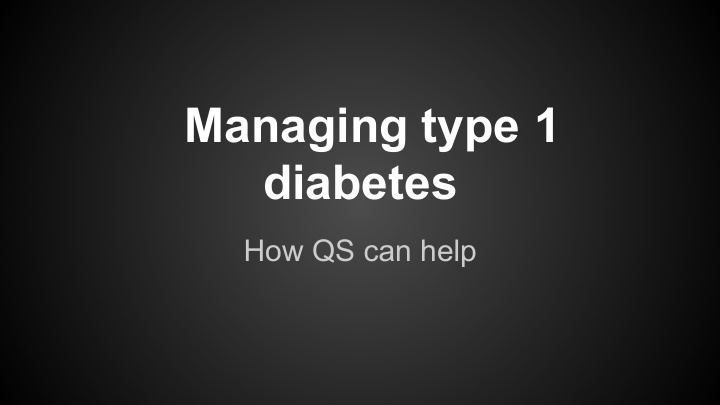



Managing type 1 diabetes How QS can help
What is type 1 diabetes? ● My immune system is killing off the insulin producing cells in my pancreas. ● I need to inject insulin to allow my body to absorb sugar from my blood. Insulin dose depends on amount of carbohydrate I eat. ● Because I inject, I have a risk of experiencing “hypos” - low blood sugar. ● I now have to do the job of my own pancreas.
Exercising with type 1 is risky ● Sensitivity to insulin increases when people exercise. ● Higher risk of hypos. In extreme cases can lead to loss of consciousness, seizure or death. ● The doctor told me exercise would be “more complicated”.
My passions - my motivations to manage type 1
QS is a powerful tool. My aims ● Learn how my blood sugar changes whilst I exercise. Do all the activities I could before, safely. ● Learn how my blood sugar is affected by food, exercise and medication choices I make on a daily basis. Minimise the risk of long term complications.
Tools - a mobile app What do I record? ● Grams of carbohydrate eaten. Meal descriptions can be free text. ● Insulin doses. ● Exercise - type, duration, free text. ● Blood sugar readings.
App
I use app for very simple analysis
What was my insulin sensitivity today?
What was my insulin sensitivity today?
More powerful tools - I use excel ● Blood sugar levels are influenced by many factors - carbs consumed, type of carb, fat consumed with carbs, exercise, heat, stress etc etc. ● I need something more powerful than apps available in the app store! ● I export data in CSV files to excel to do bespoke analysis.
How successful is my blood sugar control? Fan chart.
Analysis - exercise and BG control
Analysis - exercise and BG control
Analysis - wake up glucose
Running a lot helps glucose control
Blood glucose control whilst skiing
Limitations ● Time ● Need for simplicity. ● I wrote “complex” VBA programme to analyse data but now just use basic excel. ● Complex data analysis is hard.
Exercise ● I need to eat carbs (e.g. jelly babies) whilst exercising to prevent hypos. ● Over the first hour of exercise blood sugar varies differently. ● I test blood before, after and during exercise.
Carbohydrate needs whilst exercising ● Running. 40g per hour. First 40 minutes depend on speed or type of training. ● Climbing. Not much. ● Ski touring - walking up hill. Same as running. ● Skiing - off-piste. 20g per hour. ● Standing in very cold places. Approx 20g extra per hour.
Disadvantages with my method ● Data recording done on phone. ● Especially before bed. ● Reliant on technology working. ● My laptop is grinding to a halt.
Has QS had a positive impact? ● Hospital blood tests give a measure of average blood sugar over the past three months - called HbA1c. ● My HbA1c has been in a “healthy” range since October. My risk of suffering from diabetes-related complications is low.
Has QS had a positive impact? ● I do all the physical activity I did pre- diagnosis. ● I understand pretty well how my blood sugar responds to different factors. ● I did my first ultra marathon in December, and...
… I got the Guinness World Record for fastest marathon run in an animal costume!
For more information and more data analysis, see www.masteringdiabetes.wordpress.com
Recommend
More recommend